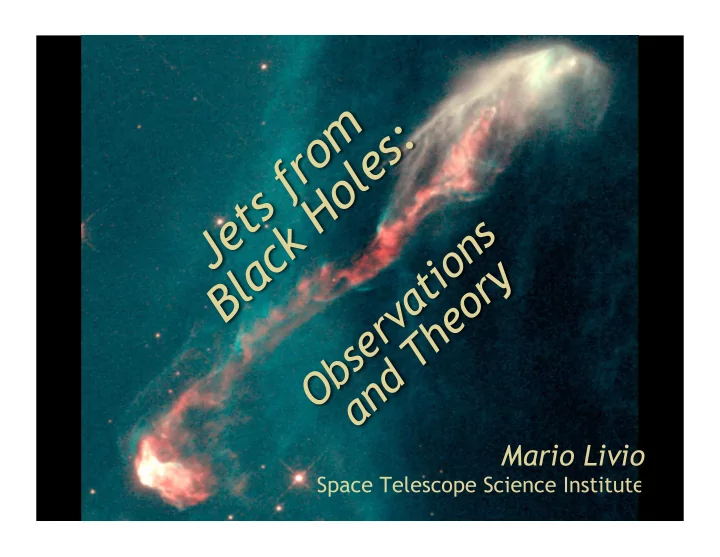

Mario Livio Space Telescope Science Institute 1
Object Physical System Ste tellar Young Stellar Objects Accreting Star HMXBs Accreting NS or BH X-ray Transients Accreting BH LMXBs Accreting NS Supersoft X-ray Sources Accreting WD Symbiotic stars Accreting WD Pulsars Rotating NS Planetary Nebulae (?) Accreting Nucleus or Interacting Winds Ex Extr tragalacti tic Object Physical System AGN Accreting Supermassive BH GRBs Accreting BH 2
3
4
5
Do FR I radio galaxies have relativistic jets like BL Lacs? 6
• GRS 1915+105 V ~ 0.9c • Some extragalactic jets show V > 0.995c 7
8
Southern Crab Nebula He2-104 STScI-PRC99-32 9
NGC 5307 NGC 3918 NGC 6543 10 NGC 7009 NGC 6826
SS 433 11
12
Vela Pulsar Crab Pulsar Chandra Chandra 13
YSOs Yes SSS Yes H/LMXBs Yes BHXTs Yes GRBs We don’t know AGN Yes PNe Not clear What are the absolutely necessary ingredients for the mechanism of jet acceleration and collimation? 14
Redshifted component not seen because of disk. 15
• MCG-6-30-15 • Gravitational redshift plus Doppler shift 16
“Interacting winds”, “ion torus”, Pulsars, GRBs, need more work 17
• Are outflows/jets the main mechanism for transport/removal of angular momentum? • Angular momentum carried by wind 18
Angular momentum that needs to be removed from disk For r A ~ 10 r , only 1% of the accreted mass needs to be lost in wind. 19
• At outburst, matter diffuses inward. Angular momentum of that matter is transferred to outer parts of the disk. Radius expands U Gem Observationally: • Disks in U Gem, OY Car, HT Cas and Z Cha larger in outburst. 20
Theory: disk instability 21
Probably not. t. • More observations of rotation in jets and bipolar outflows are needed (velocity gradients). 22
Jet Origin Object Example V jet /V escape YSOs HH30, 34 ~1 V j ~ 100-350km/s V esc ~ 500km/s AGN M87; radio sources ~1 γ >~ 3; γ <~ 10 GRBs γ ~ 100 ~1 XRBs SS 433; Cyg X-3 ~1 V j ~ 0.6c XRTs GRO 1655-40 ~1 GRS 1915+105 V j >~ 0.9c Pne Fliers, Ansae ~1 V ~ 200km/s SSS 0513-69 ~1 23 V j ~ 3800km/s
• Jets originate from the center of the accretion disk! • Models which work at all radii are probably not the “correct” ones, (e.g. self similar). 24
Two states: (i) dissipation and disk luminosity, (ii) bulk flow and jet. 25
Timescale for jet t j ~ t d 2 R/H 1/f power spectrum below a break frequency. 26
Which ingredients play a major role in the acceleration and collimation? 27
YSOs AGN XRBs SSS GRBs CVs Central object near No ? No, ? ? ? ? break-up rotation Relativistic No Yes Yes No Yes No central object “Funnel” No (?) No (?) No (?) No Yes (?) No L >~ L Edd No No No Yes ? No (Radiation pressure) (wind can be driven) Extensive hot Yes (?) Yes No No Yes (?) No atmosphere (gas pressure) Boundary layer Yes (?) No ? Yes (?) No Yes (?) 28
A reasonably ordered large-scale magnetic field threading the disk! 29
ρν 2 > B 2 8 π B 2 8 π > ρν 2 1. Acceleration like a bead on a wire up to the Alfven surface. 2. Acceleration optimal around inclination of 60°. 30
Collimation by hoop stress? BUT Kink Instability 2 2 ( B B )/8 − π z φ 31
Necessary Conditions 1. R disk / R object = Significant number of decades 2. B z largest at inner disk but largest at outer disk e.g. B z ~ ( r / R in ) -1 Good collimation obtained for R Alfven ~ R disk Consequences Minimum opening angle of jet Θ min ~ ( R in / R out ) 1/2 32
33
34
1. Why are there radio-loud and radio-quiet AGN? 2. Why do CVs appear not to produce jets while SSS do? 3. How can pulsars produce jets? 37
• The production of powerful jets requires an additional heat/wind source. • Solutions to transsonic flow in disk corona: for strong B a potential difference exists even for i > 30 ( Δφ ~ B 4 ) . 38
Central engine parameters: 39
40
• Outgoing velocity ~0.4 - 0.6 c in funnel wall jet • Poynting flux dominates within funnel • Both pressure and Lorentz forces important for acceleration • Existence of funnel jet depends on establishing radial funnel field • Jet luminosity increases with hole spin – Poynting flux jet is powered by the black hole 41
a/M η EM -0.9 0.023 0.0 0.0003 0.5 0.0063 0.9 0.046 0.93 0.038 0.95 0.072 0.99 0.21 42
M (M ʘ ) a * Source 1655-40 6.3+-0.27 ~0.7 1543-47 9.4+-1.0 ~0.8 LMC X-3 ~7 <0.26 M33 X-7 15.65+-1.45 ~0.77 1915+105 14+-4.4 >0.98 • R ISCO , a * , determined on the basis of x-ray continuum data (even beyond thermal- dominant state). • Study of plunging orbits important. Spin estimates based on stress-free inner boundary condition give upper limit on a * ? 43
1. Determinations of the collimation scale in all classes of objects. 2. Detection and measurement of rotation and of toroidal magnetic fields in jets and bipolar outflows. 3. Searches for jets in other SSS, in PNe, in other XRTs (during flares, e.g. A0620-00, GS2023+338, GS 1124-683, Cen X-4, AQL X-1), and other symbiotic systems, in CVs! 4. Determination of black hole masses in AGN. 5. Determination of black hole spins. 6. Observations of collimated jets in pulsars. 7. Afterglow light curves and breaks in GRBs. 8. Differences between short and long burst in GRBs. 44
Recommend
More recommend